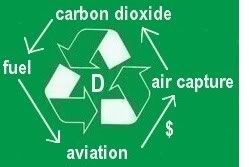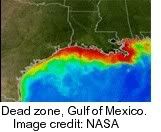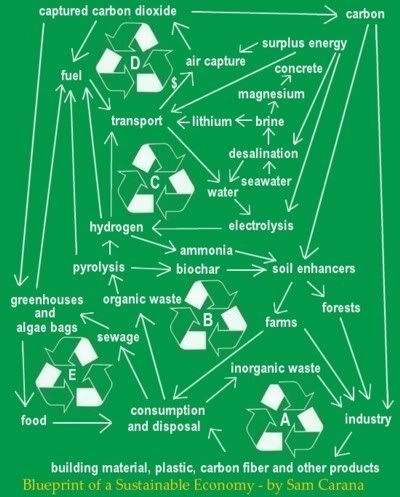Air capture of carbon dioxide is an essential part of the blueprint to reduce carbon dioxide to acceptable levels. Fees on conventional jet fuel seem the most appropriate way to raise funding to help with the development of air capture technology.
Why target jet fuel? In most other industries, there are ready alternatives to the use of fossil fuel. Electricity can be produced by wind turbines or by solar or geothermal facilities with little or no emissions of greenhouse gases. In the case of aviation, though, the best we can aim for, in the near future at least, is biofuel.
Technically, there seem to be no problems in powering aircraft with biofuel. Back in Jan 7, 2009, a Continental Airlines commercial aircraft (a Boeing 737-800) was powered in part by algae oil, supplied by Sapphire Energy. The main hurdle appears to be that algae oil is not perceived as price-competitive with fossil fuel-based jet fuel.
 Additionally, the aviation industry can offset emissions, e.g. by funding air capture of carbon dioxide. The carbon dioxide thus captured could be partly used to produce fuel, which could in turn be used by the aviation industry, as pictured on the left. The carbon dioxide could also be used to assist growth of biofuel, e.g. in greenhouses.
Algae can grow 20 to 30 times faster than food crops. A CNN report, more than a year ago, mentions Vertigro's claim to be able to grow 100,000 gallons of algae oil per acre per year by growing algae in clear plastic bags suspended vertically in a greenhouse. Given the right temperature and sufficient supply of light, water and nutrients, algae seem able to supply an almost limitless amount of biofuel.
The potential of algae has been known for decades. As another CNN report describes, the U.S. Department of Energy (DoE) had a program for nearly two decades, to study the potential of algae as a renewable fuel. The program was run by the DoE's National Renewable Energy Laboratory (NREL) and was terminated by 1996. At that time, a NREL report concluded that an area around the size of the U.S. state of Maryland could cultivate algae to produce enough biofuel to satisfy the entire transportation needs of the U.S.
In conclusion, it would make sense to impose fees on conventional jet fuel and use the proceeds of those fees to fund air capture of carbon dioxide.
Additionally, the aviation industry can offset emissions, e.g. by funding air capture of carbon dioxide. The carbon dioxide thus captured could be partly used to produce fuel, which could in turn be used by the aviation industry, as pictured on the left. The carbon dioxide could also be used to assist growth of biofuel, e.g. in greenhouses.
Algae can grow 20 to 30 times faster than food crops. A CNN report, more than a year ago, mentions Vertigro's claim to be able to grow 100,000 gallons of algae oil per acre per year by growing algae in clear plastic bags suspended vertically in a greenhouse. Given the right temperature and sufficient supply of light, water and nutrients, algae seem able to supply an almost limitless amount of biofuel.
The potential of algae has been known for decades. As another CNN report describes, the U.S. Department of Energy (DoE) had a program for nearly two decades, to study the potential of algae as a renewable fuel. The program was run by the DoE's National Renewable Energy Laboratory (NREL) and was terminated by 1996. At that time, a NREL report concluded that an area around the size of the U.S. state of Maryland could cultivate algae to produce enough biofuel to satisfy the entire transportation needs of the U.S.
In conclusion, it would make sense to impose fees on conventional jet fuel and use the proceeds of those fees to fund air capture of carbon dioxide.
 Apart from growing algae in greenhouses, we should also consider growing them in bags. NASA scientists are proposing algae bags as a way to produce renewable energy that does not compete with agriculture for land or fresh water. It uses algae to produce biofuel from sewage, using nutrients from waste water that would otherwise be dumped and contribute to pollution and dead zones in the sea.
Apart from growing algae in greenhouses, we should also consider growing them in bags. NASA scientists are proposing algae bags as a way to produce renewable energy that does not compete with agriculture for land or fresh water. It uses algae to produce biofuel from sewage, using nutrients from waste water that would otherwise be dumped and contribute to pollution and dead zones in the sea.
 The NASA article conservatively mentions that some types of algae can produce over 2,000 gallons of oil per acre per year. In fact, most of the oil we are now getting out of the ground comes from algae that lived millions of years ago. Algae still are the best source of oil we know.
In the NASA proposal, there's no need for land, water, fertilizers and other nutrients. As the NASA article describes, the bags are made of inexpensive plastic. The infrastructure to pump sewage to the sea is already in place. Economically, the proposal looks sound, even before taking into account environmental benefits.
Jonathan Trent, lead research scientist on the Spaceship Earth project at NASA Ames Research Center, Moffett Field, California, envisages large plastic bags floating on the ocean. The bags are filled with sewage on which the algae feed. The transparent bags collect sunlight that is used by the algae to produce oxygen by means of photosynthesis. The ocean water helps maintain the temperature inside the bags at acceptable levels, while the ocean's waves also keep the system mixed and active.
The NASA article conservatively mentions that some types of algae can produce over 2,000 gallons of oil per acre per year. In fact, most of the oil we are now getting out of the ground comes from algae that lived millions of years ago. Algae still are the best source of oil we know.
In the NASA proposal, there's no need for land, water, fertilizers and other nutrients. As the NASA article describes, the bags are made of inexpensive plastic. The infrastructure to pump sewage to the sea is already in place. Economically, the proposal looks sound, even before taking into account environmental benefits.
Jonathan Trent, lead research scientist on the Spaceship Earth project at NASA Ames Research Center, Moffett Field, California, envisages large plastic bags floating on the ocean. The bags are filled with sewage on which the algae feed. The transparent bags collect sunlight that is used by the algae to produce oxygen by means of photosynthesis. The ocean water helps maintain the temperature inside the bags at acceptable levels, while the ocean's waves also keep the system mixed and active.
 The bags will be made of “forward-osmosis membranes”, i.e. semi-permeable membranes that allow fresh water to flow out into the ocean, while preventing salt from entering and diluting the fresh water inside the bag. Making the water run one way will retain the algae and nutrients inside the bags. Through osmosis, the bags will also absorb carbon dioxide from the air, while releasing oxygen. NASA is testing these membranes for recycling dirty water on future long-duration space missions.
As the sewage is processed, the algae grow rich, fatty cells that are loaded with oil. The oil can be harvested and used, e.g., to power airplanes.
In case a bag breaks, it won’t contaminate the local environment, i.e. leakage won't cause any worse pollution than when sewage is directly dumped into the ocean, as happens now. Exposed to salt, the fresh water algae will quickly die in the ocean.
The bags are expected to last two years, and will be recycled afterwards. The plastic material may be used as plastic mulch, or possibly as a solid amendment in fields to retain moisture.
The bags will be made of “forward-osmosis membranes”, i.e. semi-permeable membranes that allow fresh water to flow out into the ocean, while preventing salt from entering and diluting the fresh water inside the bag. Making the water run one way will retain the algae and nutrients inside the bags. Through osmosis, the bags will also absorb carbon dioxide from the air, while releasing oxygen. NASA is testing these membranes for recycling dirty water on future long-duration space missions.
As the sewage is processed, the algae grow rich, fatty cells that are loaded with oil. The oil can be harvested and used, e.g., to power airplanes.
In case a bag breaks, it won’t contaminate the local environment, i.e. leakage won't cause any worse pollution than when sewage is directly dumped into the ocean, as happens now. Exposed to salt, the fresh water algae will quickly die in the ocean.
The bags are expected to last two years, and will be recycled afterwards. The plastic material may be used as plastic mulch, or possibly as a solid amendment in fields to retain moisture.
 A 2007 Bloomberg report estimated that the Gulf of Mexico's Dead Zone would reach more than half the size of Maryland that year and stretch into waters off Texas. The Dead Zone endangers a $2.6 billion-a-year fishing industry. The number of shrimp fishermen licensed in Louisiana has declined 40% since 2001. Meanwhile, U.S. farmers in the 2007 spring planted the most acreage with corn since 1944, due to demand for ethanol. As the report further describes, the Dead Zone is fueled by nitrogen and other nutrients pouring into the Gulf of Mexico, and corn in particular contributes to this as it uses more nitrogen-based fertilizer than crops such as soybeans.
The Louisiana coast seems like a good place to start growing algae in bags floating in the sea, filled with sewage that would otherwise be dumped there. It does seem a much better way to produce biofuel than by subsidizing corn ethanol.
According to zFacts.com, corn ethanol subsidies totaled $7.0 billion in 2006 for 4.9 billion gallons of ethanol. That's $1.45 per gallon of ethanol (or $2.21 per gallon of gas replaced). As zFacts.com explains, besides failing to help with greenhouse gases and having serious environmental problems, corn ethanol subsidies are very expensive, and the political backlash in the next few years, as production and subsidies double, will damage the effort to curb global warming.
At UN climate talks in Bonn, the world's poorest nations proposed a levy of about $6 on every flight to help them adapt to climate change. Benito Müller, environment director of the Oxford Institute for Energy Studies and author of the proposal, said that air freight was deliberately not included. The levy could raise up to $10 billion per year and would increase the average price of an international long-haul fare by less than 1% for standard class passengers, but up to $62 for people traveling first class.
In the light of those amounts, it doesn't seems unreasonable to expect that fees imposed on conventional jet fuel could raise billions per year. Proceeds could then be used to fund rebates on air capture of carbon dioxide, which could be pumped into the bags on location to enhance algae growth. Air capture devices could be powered by surplus energy from offshore wind turbines. With the help of such funding, the entire infrastructure could be set up quickly, helping the environment, creating job opportunities, making the US less dependent on oil imports, while leaving us with more land and water to grow food, resulting in lower food prices.
A 2007 Bloomberg report estimated that the Gulf of Mexico's Dead Zone would reach more than half the size of Maryland that year and stretch into waters off Texas. The Dead Zone endangers a $2.6 billion-a-year fishing industry. The number of shrimp fishermen licensed in Louisiana has declined 40% since 2001. Meanwhile, U.S. farmers in the 2007 spring planted the most acreage with corn since 1944, due to demand for ethanol. As the report further describes, the Dead Zone is fueled by nitrogen and other nutrients pouring into the Gulf of Mexico, and corn in particular contributes to this as it uses more nitrogen-based fertilizer than crops such as soybeans.
The Louisiana coast seems like a good place to start growing algae in bags floating in the sea, filled with sewage that would otherwise be dumped there. It does seem a much better way to produce biofuel than by subsidizing corn ethanol.
According to zFacts.com, corn ethanol subsidies totaled $7.0 billion in 2006 for 4.9 billion gallons of ethanol. That's $1.45 per gallon of ethanol (or $2.21 per gallon of gas replaced). As zFacts.com explains, besides failing to help with greenhouse gases and having serious environmental problems, corn ethanol subsidies are very expensive, and the political backlash in the next few years, as production and subsidies double, will damage the effort to curb global warming.
At UN climate talks in Bonn, the world's poorest nations proposed a levy of about $6 on every flight to help them adapt to climate change. Benito Müller, environment director of the Oxford Institute for Energy Studies and author of the proposal, said that air freight was deliberately not included. The levy could raise up to $10 billion per year and would increase the average price of an international long-haul fare by less than 1% for standard class passengers, but up to $62 for people traveling first class.
In the light of those amounts, it doesn't seems unreasonable to expect that fees imposed on conventional jet fuel could raise billions per year. Proceeds could then be used to fund rebates on air capture of carbon dioxide, which could be pumped into the bags on location to enhance algae growth. Air capture devices could be powered by surplus energy from offshore wind turbines. With the help of such funding, the entire infrastructure could be set up quickly, helping the environment, creating job opportunities, making the US less dependent on oil imports, while leaving us with more land and water to grow food, resulting in lower food prices.
Geo-engineering is the study and implementation of technical ways to change (and arguably improve) things like weather patterns, river paths, soils, climates and sea currents on Earth. Recently, geo-engineering has received special attention for efforts to combat global warming.
Monday, May 4, 2009
Funding of Carbon Air Capture
Labels:
air capture,
algae,
bags,
biofuel,
geoengineering,
Jonathan Trent,
membranes,
NASA,
ocean,
oil,
osmosis,
renewable energy,
sewage,
sustainable economy,
water
Monday, April 20, 2009
Open Letter to Major Economies Forum on Energy and Climate
Forum Participants,
We, a group of scientists, researchers and other people sharing a strong background and interest in climate change, are concerned that the Forum's sole focus will be on the politics of energy, as seems confirmed by the name of the Forum.
We believe that the scientific evidence strongly suggests that the approach to the climate change problem should be as broadly based as possible. As such, this should include the following four parts:
Part A: Emissions reduction
Part B: Carbon stock management
Part C: Heat transfer and radiation management
Part D: Adaptation
We note that there is little or no funding for research and testing of geoengineering methods (in Part B and Part C). These should be urgently considered as part of a comprehensive approach to climate change.
Signatories:
- John Nissen (jn@cloudworld.co.uk)
- Andrew Lockley (Former director of Friends of the Earth ENWI - UK)
- Peter Read (Hon. Research Fellow, Massey University Centre for Energy Research - NZ)
- Bill Fulkerson (Senior Fellow, Institute for a Secure and Sustainable Environment, University of Tennessee)
- Dan Wylie-Sears
- Eugene I. Gordon
- John Gorman (MA (Chartered Engineer MIMechE, MIET - UK)
- Jim Woolridge (former Climate and Energy Campaigner, Earthwatch/Friends of the Earth, Ireland)
- Sam Carana (contributor to feebate.net - sam.carana@gmail.com)
References:
White House Announcement of Major Economies Forum (MEF)
White House Announcement of Mexico MEF Meeting
Department of State Annoucement of MEF
Open letter to Dr Rajendra K. Pachauri, IPCC chair (Gather)
Open letter to Dr Rajendra K. Pachauri, IPCC chair (Geo-engineering)
Open Letter to Major Economies Forum Participants (background)
We, a group of scientists, researchers and other people sharing a strong background and interest in climate change, are concerned that the Forum's sole focus will be on the politics of energy, as seems confirmed by the name of the Forum.
We believe that the scientific evidence strongly suggests that the approach to the climate change problem should be as broadly based as possible. As such, this should include the following four parts:
Part A: Emissions reduction
Part B: Carbon stock management
Part C: Heat transfer and radiation management
Part D: Adaptation
We note that there is little or no funding for research and testing of geoengineering methods (in Part B and Part C). These should be urgently considered as part of a comprehensive approach to climate change.
Signatories:
- John Nissen (jn@cloudworld.co.uk)
- Andrew Lockley (Former director of Friends of the Earth ENWI - UK)
- Peter Read (Hon. Research Fellow, Massey University Centre for Energy Research - NZ)
- Bill Fulkerson (Senior Fellow, Institute for a Secure and Sustainable Environment, University of Tennessee)
- Dan Wylie-Sears
- Eugene I. Gordon
- John Gorman (MA (Chartered Engineer MIMechE, MIET - UK)
- Jim Woolridge (former Climate and Energy Campaigner, Earthwatch/Friends of the Earth, Ireland)
- Sam Carana (contributor to feebate.net - sam.carana@gmail.com)
References:
White House Announcement of Major Economies Forum (MEF)
White House Announcement of Mexico MEF Meeting
Department of State Annoucement of MEF
Open letter to Dr Rajendra K. Pachauri, IPCC chair (Gather)
Open letter to Dr Rajendra K. Pachauri, IPCC chair (Geo-engineering)
Open Letter to Major Economies Forum Participants (background)
Monday, March 9, 2009
Open letter to Dr Pachauri
Climate Congress, Copenhagen, 10-12 March, 2009
Open letter to Dr Rajendra K. Pachauri, IPCC chair
Dear Dr Pachauri,
The Climate Congress presents an important opportunity to present all facets of the current situation, explore the ramifications, and suggest appropriate actions. The aim must be, as far as possible, to address the threat of a disastrous multi-metre rise in sea level and catastrophic multi-degree rise in temperature – whenever they might occur.
We would like to suggest a rather simple division of the problem/solution domain:
Part A: Emissions reduction
About: Reducing emissions of greenhouse gases into the atmosphere.
Target: Achieve near-zero carbon economies throughout the world by end century.
Difficulties: International agreement, life-style changes, high cost.
Rationale: Long-term sustainability.
Part B : Carbon stock management
About: Removing CO2 from the atmosphere by various means.
Target: Reduce levels below 350 ppm over next three decades.
Difficulties: May involve change in agricultural practice, worldwide. Side-effects may be difficult to anticipate.
About: Reducing emissions of greenhouse gases into the atmosphere.
Target: Achieve near-zero carbon economies throughout the world by end century.
Difficulties: International agreement, life-style changes, high cost.
Rationale: Long-term sustainability.
Part B : Carbon stock management
About: Removing CO2 from the atmosphere by various means.
Target: Reduce levels below 350 ppm over next three decades.
Difficulties: May involve change in agricultural practice, worldwide. Side-effects may be difficult to anticipate.
Rationale: Reduce CO2 climate forcing below its current level, halt ocean acidification and protect carbon sinks.
Part C : Heat transfer and radiation management
Part C : Heat transfer and radiation management
About: Mainly about albedo engineering and solar radiation management.
Priority target: Cool the Arctic sufficient to halt retreat of Arctic sea ice within three years.
Difficulties: Seen as tampering with the environment, and therefore intrinsically dangerous; but cost is low and side-effects should be manageable.
Rationale: Reduce risk of massive methane discharge and stabilise the Greenland ice sheet.
International focus has been almost entirely on Part A until recently, when it has been realised that:
(1) it is proving extremely difficult to achieve reductions;
(2) the current trend is towards IPCC’s worst case scenario;
(3) lifetime of CO2 had been under-estimated – even if anthropogenic greenhouse gases could be stopped overnight, the existing gas levels will live on in the atmosphere for centuries, causing the global temperature to continue to rise many degrees;
(4) global warming of more than 2 degrees could be disastrous;
(5) tipping points could be reached much sooner than expected.
It is generally recognised that the underlying primary cause of global warming is the excess of CO2 in the atmosphere. If emissions reduction can’t reduce it quickly enough, then we have to resort to some form of geoengineering – or more specifically carbon stock management – see Part B.
Furthermore, ocean acidification is becoming dangerous, and this can only be tackled by removing CO2 from the atmosphere. So, within a decade or two, carbon stock management could become essential, and we should be doing large-scale experimentation now.
But the actions of Part A and Part B cannot prevent tipping points driven by positive feedback on temperature. Emissions reduction and carbon stock management cannot produce a cooling effect – certainly not on the time-scales we are talking about. We have to resort to other kinds of geoengineering, hence Part C.
As regards tipping points, our perception of the situation has changed fundamentally since the dramatic retreat of Arctic sea ice in September 2007. The IPCC had chosen to ignore potential tipping points, as being too difficult to model or lacking reliable data.
But now some experts are talking about possible summer disappearance of sea ice within a decade [1], and this possibility is even mentioned in the introduction to Session 1 of the Congress [2]:
“Sea ice is changing and the sea ice in the northern polar ocean has retreated in the last few years and might totally disintegrate during the next decade.”
Sea ice disappearance will accelerate Arctic warming which could trigger the release of vast amounts of methane from permafrost (leading to many degrees of global warming) and/or destabilise the Greenland ice sheet (leading to many metres of sea level rise).
There now appears no other possibility to save the Arctic sea ice than to cool the Arctic region, by reflecting more sunlight back into space. There are two prime candidates for this: stratospheric sulphate aerosols and marine cloud brightening [3]. The former involves the injection of a H2S or SO2 high in the stratosphere, where it reacts to form microscopic droplets of sulphuric acid which scatter sunlight efficiently. This mimics the effect of a volcano like Pinatubo, which cooled the planet for two years from its sulphur emissions into the stratosphere. The latter – the brightening of marine clouds – involves producing a very fine spray of sea water from ships which sail underneath low-lying cumulus clouds, such that some of the spray wafts upwards, brightening the clouds and reflecting light back into space.
Modeling suggests that each of these cooling technologies should be effective, affordable, fast acting, easily reversible and reasonably safe.
If we can save the Arctic sea ice, then we may be able to avoid other tipping points such as the methane release from permafrost. Such action buys time while we reduce CO2 levels and avoid other catastrophes such as from ocean acidification. On the other hand, if we do not act with the necessary urgency, we may soon find ourselves beyond the point of no return: doomed both to many metres of sea level rise and to spiraling temperatures, way above 6 degrees this century – temperatures for which the very survival of our civilization would be in question.
- John Nissen
Email: jn@cloudworld.co.uk for correspondence
- Stephen Salter
Professor of Engineering, University of Edinburgh
John Latham
http://www.mmm.ucar.edu/people/latham/
- Oliver Wingenter
Professor of Atmospheric Chemistry and Climate Change,
New Mexico Institute of Mining and Technology
- Peter Read
Hon. Research Fellow, Massey University Centre for Energy Research
- Andrew Lockley, London UK
Former director of Friends of the Earth ENWI
- John Gorman MA (Cantab), London, UK
- Sam Carana, contributor to feebate.net
sam.carana@gmail.com
References:
[1] Climate Safety report, which can be downloaded from:
References:
[1] Climate Safety report, which can be downloaded from:
Subscribe to:
Posts (Atom)
